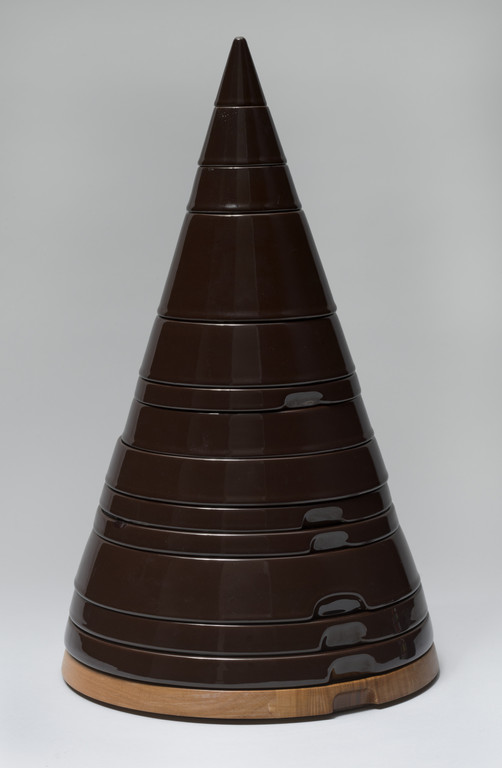
Ambrogio Pozzi (b. 1931) was an Italian industrial designer. He began his career at Ceramica Franco Pozzi, the family firm in Gallarate, in 1951. There, he garnered recognition for his award-winning redesign of traditional products in a functional style. One of his notable creations was the Compact stacking coffee service, introduced in 1970, which gained widespread acclaim and was designed for machine production in three sizes.
Biography
Later, Pozzi established his design practice, catering to clients such as Riedel, Rossi, Guzzini, Pierre Cardin, Rosenthal, Norex, La Rinascente department store, and Alitalia. His collaborations with Rosenthal resulted in the production of the Duo dinnerware in 1968 and a limited-edition cup and saucer in 1987, which were included in the Collector’s Cup range.
Exhibitions
Pozzi was a member of ADI (Associazione per il Disegno Industriale). Throughout his career, he actively participated in various exhibitions. From 1954 to 1973, he showcased his work at all the Triennali di Milano events. He achieved notable recognition, winning first prizes for industrial Design in Vicenza in 1958-64, 1966, and 1970. For his contributions to his family firm, he received two Compasso d’Oro awards in 1970, one for the Compact coffee service and another for the TR 113 tableware range.
His designs were featured in the 1980 ‘Arte e design’ exhibition at the Palazzo delle Esposizioni in Faenza. The Philadelphia Museum of Art included his Duo dinnerware in the ‘Design Since 1945’ exhibition in 1983-84, where it received a gold medal. Moreover, Faenza International awarded a gold medal for his porcelain service for Alitalia in 1973. Pozzi also received the Bundespreis ‘Die gute Industrieform’ in Hanover from 1967 to 1974 and served as a jury member for various design competitions, including the 1969-70 Concorso Internazionale della Ceramica in Faenza and the 1971-74 industrial design competition in Valencia.
Works
- Pair of White Vases by Rosenthal and Thomas with Pleat Details – A$1401.19
- Ambrogio Pozzi for Rosenthal Studio-Line, Austria, White Porcelain Vase – A$1383.49
- Vintage “Pastorale” Ceramic Vase by Ambrogio Pozzi, Rosenthal Studio Line, 1960s – A$491
- Ceramic Sculpture Face Model by Ambrogio Pozzi for Superego Editions, Italy – A$906.49
- Ambrogio Pozzi Ceramic Sculpture Model Face by Superego Editions, Italy -$906.49
- “Bombolo” Ceramic Set by Ambrogio Pozzi for Ceramiche for Pozzi – A$1178.44
Sources
Byars, M., & Riley, T. (2004). The design encyclopedia. Laurence King Publishing. https://amzn.to/3ElmSlL
More Ceramicists
The Vibrant World of Gaudy Pottery: Dutch, Ironstone, and Welsh
The decorative arts showcase the Gaudy ceramics of the 19th century, highlighting three distinct styles—Gaudy Dutch, Gaudy Ironstone, and Gaudy Welsh—each representing cultural trends and…
Keep readingHow Japanese Lusterware Achieves Its Unique Optical Properties
Japanese lusterware features a pearlescent finish from metallic nanoparticles, created through intricate firing techniques, resulting in unique optical properties and vibrant colors.
Keep readingMichael Schilkin: The Renowned Russian Ceramicist
Michael Schilkin, a renowned ceramic artist from Russia, blended folk art with Scandinavian design, creating detailed animal sculptures that continue to inspire contemporary artisans and…
Keep readingSusumu Ikuta: Japanese Ceramicist and Fashion Designer
Susumu Ikuta a Japanese ceramicist, studied traditional techniques under Katoh Kohbei. He worked in Tokyo, New York, and North Carolina, incorporating realistic motifs into porcelain…
Keep readingThe Exquisite Art of Porcelain: Crafting Delicate Elegance
Porcelain is a remarkable ceramic material known for its hardness, delicacy, and characteristic translucence. Often associated with an elegant and refined appearance, porcelain has been…
Keep reading18th Century Agateware: Techniques, Aesthetic, and Makers
Agate ware, popular in 18th-century England, mimics natural agate stone with marbled clay. Modern artisans continue its legacy with innovative techniques. Valued for history and…
Keep readingRelated Articles
Discover more from Encyclopedia of Design
Subscribe to get the latest posts sent to your email.






